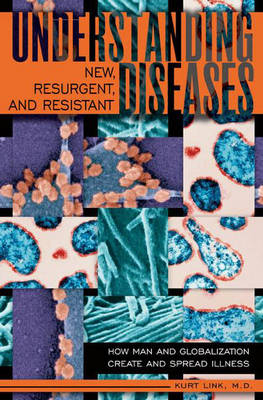
Understanding New, Resurgent, and Resistant Diseases
How Man and Globalization Create and Spread Illness
Seiten
2007
Praeger Publishers Inc (Verlag)
978-0-275-99126-5 (ISBN)
Praeger Publishers Inc (Verlag)
978-0-275-99126-5 (ISBN)
Explains the extent of new, resurgent and resistant diseases which defy the abilities of science and medicine, or often just find strength because of globalisation or other facets of modernisation. This work also explains why such diseases are not prevented by our systems, and why some rare diseases persist despite technology that could cure them.
In this work, Dr. Link explains the extent of new, resurgent, and resistant diseases defying the abilities of science and medicine, or often finding strength in globalization or other facets of modernization.
Although medicine and sanitation in modernized countries are more advanced than ever before, over the past three decades we have seen the emergence of some 30 new diseases, such as HIV, SARS, and Ebola. Lyme Disease, Hepatitis C, Legionnaires' Disease, and even Jacob-Creutzfeld, the human form of a disorder we know as Mad Cow, has made headlines. We are also facing a resurgence of diseases once thought nearly eradicated, including tuberculosis and smallpox, and the persistence of rare disorders such as leprosy.
Link also explains why such diseases are not prevented by our current systems, and why some rare diseases persist despite technology that could cure them. He offers insight into why we may not be able to predict or prevent factors such as mutations, and also shares thoughts about what we can do—as individuals, communities and countries—to reduce the dangers of disease. Including a basic review of elements that cause them—viruses, bacteria, parasites, and fungi among them—this work gives a brief history of human diseases and points out how the burden of disease has increased throughout the history of mankind.
In this work, Dr. Link explains the extent of new, resurgent, and resistant diseases defying the abilities of science and medicine, or often finding strength in globalization or other facets of modernization.
Although medicine and sanitation in modernized countries are more advanced than ever before, over the past three decades we have seen the emergence of some 30 new diseases, such as HIV, SARS, and Ebola. Lyme Disease, Hepatitis C, Legionnaires' Disease, and even Jacob-Creutzfeld, the human form of a disorder we know as Mad Cow, has made headlines. We are also facing a resurgence of diseases once thought nearly eradicated, including tuberculosis and smallpox, and the persistence of rare disorders such as leprosy.
Link also explains why such diseases are not prevented by our current systems, and why some rare diseases persist despite technology that could cure them. He offers insight into why we may not be able to predict or prevent factors such as mutations, and also shares thoughts about what we can do—as individuals, communities and countries—to reduce the dangers of disease. Including a basic review of elements that cause them—viruses, bacteria, parasites, and fungi among them—this work gives a brief history of human diseases and points out how the burden of disease has increased throughout the history of mankind.
Kurt Link, M.D. is a retired Internist who has authored several books, including Understanding the Vaccine Controversy (Praeger, 2005).
| Erscheint lt. Verlag | 30.5.2007 |
|---|---|
| Sprache | englisch |
| Themenwelt | Studium ► Querschnittsbereiche ► Epidemiologie / Med. Biometrie |
| Studium ► Querschnittsbereiche ► Geschichte / Ethik der Medizin | |
| ISBN-10 | 0-275-99126-1 / 0275991261 |
| ISBN-13 | 978-0-275-99126-5 / 9780275991265 |
| Zustand | Neuware |
| Informationen gemäß Produktsicherheitsverordnung (GPSR) | |
| Haben Sie eine Frage zum Produkt? |
Mehr entdecken
aus dem Bereich
aus dem Bereich
ein überfälliges Gespräch zu einer Pandemie, die nicht die letzte …
Buch | Hardcover (2024)
Ullstein Buchverlage
24,99 €


